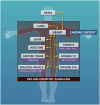Reciprocal organ interactions during heart failure: a position paper from the ESC Working Group on Myocardial Function
- PMID: 33483724
- PMCID: PMC8562335
- DOI: 10.1093/cvr/cvab009
Reciprocal organ interactions during heart failure: a position paper from the ESC Working Group on Myocardial Function
Abstract
Heart failure-either with reduced or preserved ejection fraction (HFrEF/HFpEF)-is a clinical syndrome of multifactorial and gender-dependent aetiology, indicating the insufficiency of the heart to pump blood adequately to maintain blood flow to meet the body's needs. Typical symptoms commonly include shortness of breath, excessive fatigue with impaired exercise capacity, and peripheral oedema, thereby alluding to the fact that heart failure is a syndrome that affects multiple organ systems. Patients suffering from progressed heart failure have a very limited life expectancy, lower than that of numerous cancer types. In this position paper, we provide an overview regarding interactions between the heart and other organ systems, the clinical evidence, underlying mechanisms, potential available or yet-to-establish animal models to study such interactions and finally discuss potential new drug interventions to be developed in the future. Our working group suggests that more experimental research is required to understand the individual molecular mechanisms underlying heart failure and reinforces the urgency for tailored therapeutic interventions that target not only the heart but also other related affected organ systems to effectively treat heart failure as a clinical syndrome that affects and involves multiple organs.
Keywords: Liver; Adipose tissue; Brain; Heart failure; Intestine; Kidney; Lung; Multi-organ clinical syndrome; Non-coding RNAs.
© The Author(s) 2021. Published by Oxford University Press on behalf of the European Society of Cardiology.
Figures



References
-
- Husain-Syed F, McCullough PA, Birk HW, Renker M, Brocca A, Seeger W, Ronco C. Cardio-pulmonary-renal interactions: a multidisciplinary approach. J Am Coll Cardiol 2015;65:2433–2448. - PubMed
-
- Bang C, Thum T. Exosomes: new players in cell-cell communication. Int J Biochem Cell Biol 2012;44:2060–2064. - PubMed
-
- Bar C, Thum T, de Gonzalo-Calvo D. Circulating miRNAs as mediators in cell-to-cell communication. Epigenomics 2019;11:111–113. - PubMed
-
- Bang C, Batkai S, Dangwal S, Gupta SK, Foinquinos A, Holzmann A, Just A, Remke J, Zimmer K, Zeug A, Ponimaskin E, Schmiedl A, Yin X, Mayr M, Halder R, Fischer A, Engelhardt S, Wei Y, Schober A, Fiedler J, Thum T. Cardiac fibroblast-derived microRNA passenger strand-enriched exosomes mediate cardiomyocyte hypertrophy. J Clin Invest 2014;124:2136–2146. - PMC - PubMed
Publication types
MeSH terms
Grants and funding
- BHF_/British Heart Foundation/United Kingdom
- PG/17/64/33205/BHF Project
- GA 305507/European Union Commission's Seventh Framework program
- 825670/EU Horizon 2020 project CARDIOREGENIX (GA
- 01KL1706/ERA-Net-CVD project MacroERA
- 821508/IMI2-CARDIATEAM
- CVON2016-Early HFPEF, 2015-10/Netherlands Cardiovascular Research Initiative-an initiative with support of the Dutch Heart Foundation
- CVON She-PREDICTS
- CVON Arena-PRIME, 2017-18
- CVON 2018-28 & 2012-06 Heart Brain Connection
- CVON-Dosis 2014-20
- G091018N/Research Foundation Flanders FWO
- KFO311/TH903/20/Deutsche Forschungsgemeinschaft
- IG 2016 19032/AIRC
- Dutch Federation of University Medical Centres
- Netherlands Organisation for Health Research and Development and the Royal Netherlands Academy of Sciences
- 91818602/Netherlands Organization for Sciences-ZonMW (VICI
- POCI-01-0145-FEDER-016385/Project NETDIAMOND
- European Structural and Investment Funds
- Lisbon's Regional Operational Program 2020
- Portuguese Foundation for Science and Technology
LinkOut - more resources
Full Text Sources
Other Literature Sources

